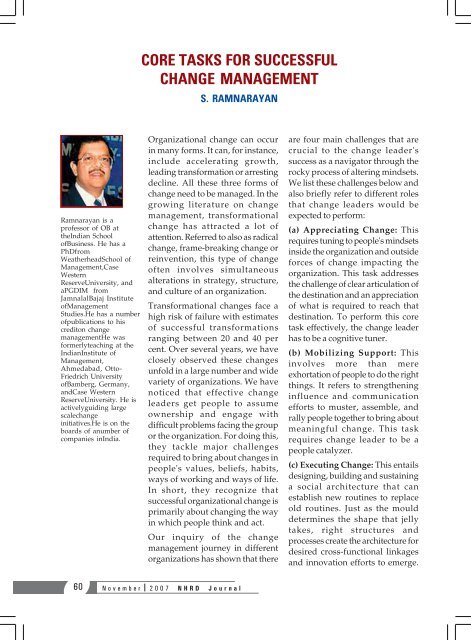NHRD Journal - National HRD Network
NHRD Journal - National HRD Network
NHRD Journal - National HRD Network
Create successful ePaper yourself
Turn your PDF publications into a flip-book with our unique Google optimized e-Paper software.
CORE TASKS FOR SUCCESSFUL<br />
CHANGE MANAGEMENT<br />
S. RAMNARAYAN<br />
Ramnarayan is a<br />
professor of OB at<br />
theIndian School<br />
ofBusiness. He has a<br />
PhDfrom<br />
WeatherheadSchool of<br />
Management,Case<br />
Western<br />
ReserveUniversity, and<br />
aPGDIM from<br />
JamnalalBajaj Institute<br />
ofManagement<br />
Studies.He has a number<br />
ofpublications to his<br />
crediton change<br />
managementHe was<br />
formerlyteaching at the<br />
IndianInstitute of<br />
Management,<br />
Ahmedabad, Otto-<br />
Friedrich University<br />
ofBamberg, Germany,<br />
andCase Western<br />
ReserveUniversity. He is<br />
activelyguiding large<br />
scalechange<br />
initiatives.He is on the<br />
boards of anumber of<br />
companies inIndia.<br />
Organizational change can occur<br />
in many forms. It can, for instance,<br />
include accelerating growth,<br />
leading transformation or arresting<br />
decline. All these three forms of<br />
change need to be managed. In the<br />
growing literature on change<br />
management, transformational<br />
change has attracted a lot of<br />
attention. Referred to also as radical<br />
change, frame-breaking change or<br />
reinvention, this type of change<br />
often involves simultaneous<br />
alterations in strategy, structure,<br />
and culture of an organization.<br />
Transformational changes face a<br />
high risk of failure with estimates<br />
of successful transformations<br />
ranging between 20 and 40 per<br />
cent. Over several years, we have<br />
closely observed these changes<br />
unfold in a large number and wide<br />
variety of organizations. We have<br />
noticed that effective change<br />
leaders get people to assume<br />
ownership and engage with<br />
difficult problems facing the group<br />
or the organization. For doing this,<br />
they tackle major challenges<br />
required to bring about changes in<br />
people's values, beliefs, habits,<br />
ways of working and ways of life.<br />
In short, they recognize that<br />
successful organizational change is<br />
primarily about changing the way<br />
in which people think and act.<br />
Our inquiry of the change<br />
management journey in different<br />
organizations has shown that there<br />
are four main challenges that are<br />
crucial to the change leader's<br />
success as a navigator through the<br />
rocky process of altering mindsets.<br />
We list these challenges below and<br />
also briefly refer to different roles<br />
that change leaders would be<br />
expected to perform:<br />
(a) Appreciating Change: This<br />
requires tuning to people's mindsets<br />
inside the organization and outside<br />
forces of change impacting the<br />
organization. This task addresses<br />
the challenge of clear articulation of<br />
the destination and an appreciation<br />
of what is required to reach that<br />
destination. To perform this core<br />
task effectively, the change leader<br />
has to be a cognitive tuner.<br />
(b) Mobilizing Support: This<br />
involves more than mere<br />
exhortation of people to do the right<br />
things. It refers to strengthening<br />
influence and communication<br />
efforts to muster, assemble, and<br />
rally people together to bring about<br />
meaningful change. This task<br />
requires change leader to be a<br />
people catalyzer.<br />
(c) Executing Change: This entails<br />
designing, building and sustaining<br />
a social architecture that can<br />
establish new routines to replace<br />
old routines. Just as the mould<br />
determines the shape that jelly<br />
takes, right structures and<br />
processes create the architecture for<br />
desired cross-functional linkages<br />
and innovation efforts to emerge.<br />
60<br />
November 2007 <strong>N<strong>HRD</strong></strong> <strong>Journal</strong>
















